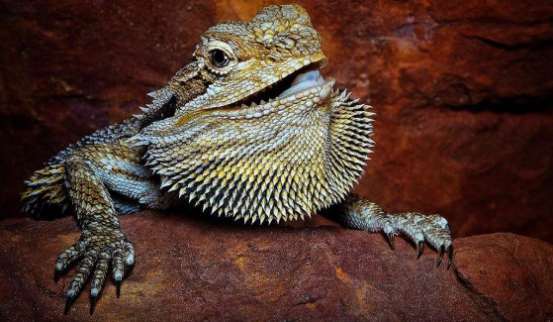While birds and mammals have melanocytes, some reptiles, fish, amphibians, cephalopod, and crustaceans have chromatophores. Chromatophores “are pigment-containing and light-reflecting cells (1) that generate eye and skin colors in ectotherms, including bearded dragons.
Furthermore, depending on the cause, a bearded dragon color change may target specific areas such as the head, neck, tail, stomach, chest regions, belly, or happen all over.

Why is my bearded dragon turning darker (black) or paler (white)?
There are many reasons why your beardie may turn darker or lighter. While in most cases, the change is ok, there are cases when it may be abnormal.
The fundamental reasons for color change are to thermoregulate, camouflage, and communicate with other lizards. Some of the reasons why these pets became darker or lighter include:
1. Light and darkness
Light or darkness may be the reasons for the sudden color change, shows research by Maria Fan et al. of the University of Melbourne. These changes corresponded to the photoperiod and not just in response to this reptile’s cardigan rhythm.
Usually, when you expose them to much light, such as during basking under their heat lamps or on direct sunlight, their dorsal skin will darken.
On the other hand, if exposed to darkness such as at night, their skin will be lighter. Continuous stay in darkness will make them turn lightest.
Therefore, if their color becomes brighter such as bright orange, light brown, or light yellow from a darker shade of these colors, there is nothing to worry about as it normal
2. Thermoregulation
Besides light, the temperature is another factor that may influence a change in coloration in beardies as this change affects the dorsal reflectivity of these reptiles. Research by Kathleen R. Smith and her colleges at the University of Melbourne confirms this hypothesis.
Since a black body absorbs more heat and reflects less, bearded dragon’s dorsal turn black or darker when they are cold. This change makes them absorb more heat and quickly gain their preferred temperature. During this time, they may flatten their body to allow maximum heat absorption.
On the other hand, if the temperature is high, they will want to reduce the amount of heat they absorb. For these pets to reduce heat absorbed, their back will turn whiter or paler such as pale yellow.
These changes in coloration will help you know if your terrarium temperature is too high or too low. Therefore, check vivarium temperature and ensure it is at it require level both for the colder and warmer (basking) areas.
3. As they grow
Until they are about 12-18 months, they will get more vibrant and colorful skin each time they shade, and later, it will not be as lively or colorful.
4. Shedding
They tend to turn darker as a newer skin grows beneath the old one. However, immediately after shedding, they will have a lighter and vibrant color.
To know they are about to shed, check if their color becomes darker, they hide more, eat less, become cranky, restless, and rub or scratch their bodies.
Finally, as they begin to shed, you might notice white patches anywhere, including on their tail, head, back, head, and so on. These represent the skin that has bulged out that is ready to come off their body.
5. Environmental changes
Besides the above, environmental changes can influence color change, i.e., there is always a color variation in beardies that live in different environmental conditions such as the color soil, background, or light intensity.
This change happens more or less like it does in chameleons and helps them camouflage better in their environment.
6. Stress, mood, and communication
Mood and emotions, including happiness or when they are stressed, threatened, or upset. For instance, they have bright colors such as orange, yellow, or light brown when they are happy. On the other hand, they may turn darker when ill, threatened, scared, or upset.
A little more on stress, bearded dragons do develop stress marks on their belly and chin when under much distress. They appear in the form of dark markings or spots in these areas.
Look for other symptoms of stress such as not eating, being less active, hiding, not basking, as usual, surfing as well as their body slightly darkening.
Wrong habitat setting (temperature, humidity, and lighting), excessive handling, sickness, and so on can stress these pets.
Finally, a change of their hue is a means of communicating with other bearded dragons. It will mainly involve their beard, neck, and upper chest. These areas may darken when passing cues to other lizards.
Turning yellow or grey
As we have mentioned turning to bright colors, including yellowish, may show its moods, such as happiness or a means of thermoregulation.
However, sometimes, your bearded dragon going yellow may be an indication of a yellow fungus disease, especially if you see yellowish patches. Sometimes, these patches may be greyish.
If your beardies have this condition, they will shed more and may develop lesions if left untreated.
Turning green
Is your bearded dragon turning green? Unless it is related to environmental changes, there is a chance the greenish color is due to algae, especially if they stay in areas with high humidity and poor UV light.
